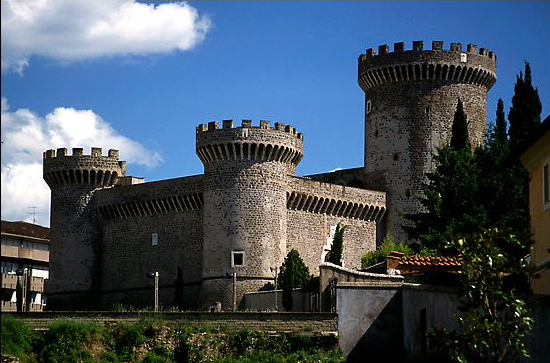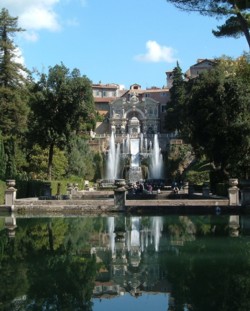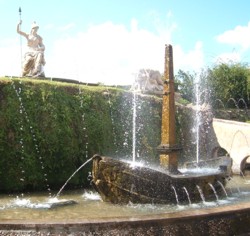Tivoli
Tivoli, a hill town not very far from Rome, features two villas very distinct in character, which both give a strong sense of faded splendor.

Villa Adriana consists of the ruins of emperor Hadrian's summer residence, which used to be one of the largest and most somptuous villas of the Ancient world. As the emperor was a keen architect and traveler, the villa is a masterpiece that uniquely reproduces the best elements of the material cultures of Egypt, Greece, and Rome in the form of an "ideal city." Study of the monuments that make up the Villa Adriana played a crucial role in the rediscovery of the elements of classical architecture by the architects of the Renaissance and the Baroque period.
Villa d'Este was the pleasure palace of Lucrezia Borgia's son. With its palace and garden, is one of the most remarkable and comprehensive illustrations of Renaissance culture at its most refined. Its innovative design along with the architectural components in the garden (elaborate gravity fed fountains, ornamental basins, etc.) make this a unique example of an Italian 16th-century garden. The Villa d'Este, one of the first giardini delle meraviglie, was an early model for the development of European gardens. In 1885, Lizt stayed in the villa, which inspired the piece `Fountains of the Villa d'Este`. Both of the villas are a UNESCO World Heritage Sites.
Tivoli is a historic hilltown in the Lazio region of Italy, and is one of the most popular destinations for daytrips from Rome. Tivoli's two most famous tourist attractions are the magnificent gardens of the Villa d'Este and the extensive ruins of Hadrian's Villa (known as the Villa Adriana).
Tivoli is situated on the Aniene river to the east of Rome, in the Monti Tiburtini hills where the climate is fresher than Rome's. For this reason, the area was popular from ancient times onwards with Rome's moneyed classes, who built summer retreats in the area. As the town was on a major trading route from Rome to the Abruzzi, Tivoli has always been an important settlement. Modern Tivoli has around 50,000 inhabitants, and spreads out far beyond the crumblingly picturesque historical centre. In the suburb of Bagni di Tivoli, on the plains below the town centre, it is still possible to bathe in natural thermal springs. The fourth century BC town wall is still visible, as are temples from the second century BC.
There is plenty to occupy the visitor in Tivoli for a day, even if they miss out one of the two famous villas. Travellers keen to see all the sights of the area should note that the Villa Adriana is actually a bus ride outside town; and they may find their day stretched to an uncomfortable length. Some visitors choose to stay in Tivoli, away from the bustle of Rome; if you are very keen on spending a long time at the monuments, or planning to travel onwards through Italy this may be an option worth considering.
Villa d'Este

The Renaissance Villa d'Este was built in the 1550s for Cardinal Ippolito d'Este, the son of Lucretia Borgia. Built over a Benedictine convent, the palace was intended for entertaining and contains lavishly frescoed reception rooms. The main attraction for visitors, however, is the breathtaking garden. Designed to impress the Cardinal's guests, the Villa d'Este's gardens are composed almost exclusively of water features. Fountains of every description dazzle the onlooker, from the grand 'Fountain of the Dragons' and 'Hundred Fountains', to a miniature watery reproduction of Rome. The centrepiece, the gigantic Water Organ Fountain, cascades down a huge drop into quiet, shady pools. Read more about the Villa d'Este
One of Italy's most admired gardens, the Villa d'Este is a sixteenth-century pleasure palace with a sequence of fantastic fountains and water features in its shady grounds.
Villa d'Este was built in 1550 for Cardinal Ippolito d'Este, the son of Lucrezia Borgia and Alfonso d'Este. It occupies a stretch of hillside below the town of Tivoli, with spectacular views over the plain towards Rome. Built around an earlier monastery, the building is lavishly decorated with frescoes, reliefs and internal fountains. The most striking part of the Villa d'Este, however, is its garden; a terraced extravaganza of shady trees and showstopping fountains. Subsequent cardinal-owners added to the gardens, which after a period of decay have been restored in recent decades.

The garden is designated a UNESCO World Heritage Site in recognition of its significance in the history of garden design, and its fountains are famous worldwide. Film fans will recognise many of the garden's features in the opening sequence of Three Coins in the Fountain.
The current unassuming entrance is set in the back of the building, and it's only by descending a flight of stairs and passing through ornately-decorated (but unfurnished) chambers that the visitor reaches the front of the building. Once, the main approach would have brought visitors before this grand facade; now it comes as a sudden surprise.
A number of paths and steps lead down through the formal slopes to panoramas and fountains. The Rometta is a tribute to Rome; a water feature which incorporates recreations of the city's monuments; the Bicchierone fountain is a later addition by Bernini; the Ovato is an atmospheric fountain backed by a nymphaeum. Other highlights include the Fountain of the Dragons, a many-breasted sculpture of Diana, the long path of the Hundred Fountains and the massive cascade below the Water Organ.
A number of the novelty fountains are activated during the day, with times displayed at the entrance. At the Fountain of the Owl, birds warble until a model owl appears to scare them into silence, while the Water Organ periodically offers musical entertainment to visitors. Notice boards and plans dotted around the garden offer historical information about the fountains, in English as well as Italian.
A reasonable self-service caffeteria on the terrace level offers tourists the chance to enjoy a meal or refreshments while enjoying the views over the gardens.
The Villa comes into its own on a hot summer's day, when visitors fleeing from the heat of Rome will appreciate the cooling combination of location, shade and cold running water. Tivoli is easy to reach from Rome, and the Villa d'Este is a mere two-minutes' walk from the bus stop (follow the chain of souvenir stalls). The gardens can be visited as a half-day trip, although many visitors will prefer to take their time, and enjoy a meal in the town or on the garden terrace overlooking the hot plains.
Villa Adriana
For those with an interest in antiquities, the Villa Adriana is worth a day to itself. The Emperor Hadrian conceived a countryside dwelling here that would by normal standards be considered a town. A gigantic complex with underground service passages big enough for vehicles (tantalising glimpses are still visible), the Villa incorporates lakes, fountains, libraries, baths, temples and gardens. The area covered is staggering, and highly confusing even when armed with a map; it's easy to imagine the Emperor himself needing guidance.
Hadrian supervised the building work personally, and architectural features were included to remind the Emperor of his travels, of the countries he had visited and the times spent with his drowned favourite, Antinoos, around whose youthful charm a cult was established. The Emperor who built a wall across Britain was an educated, complex and interesting soldier. To add to the experience of the Villa Adriana, Marguerite Yourcenar's fictionalised 'autobiography', Memoirs of Hadrian, provides a moving and learned insight into the time when the Villa was constructed.
Tivoli's other sights
Villa Gregoriana, an impressive park set in a gorge with a 100m waterfall. The site is currently being restored and is closed to the public. Views over the gorge can still be enjoyed from the Ponte Gregoriano.
Temple of Vesta and Temple of the Sybil - the characteristic round Temple of Vesta occupies a panoramic position above the valley of the Villa Gregoriana, about ten minutes' walk from the Villa d'Este. A squarish ruin next to the round temple is thought to have been a temple dedicated to the Sybil. Around the temples are dotted the tables of a restaurant; a pleasant place to relax in the middle of antiquity. The area where both these temples is located was the ancient acropolis, and provides excellent views of the cascades and valley below.
Ponte Gregoriano - there was a devastating flood in the 1800s; afterwards the river was diverted and this bridge was built. It was destroyed by retreating German troops in 1944, but rebuilt afterwards. The bridge offers impressive views over the gorge, waterfall and temple immortalised in so many paintings dating from the Grand Tour era.
Picking up a town map at the Tourist Office (a dark green kiosk close to the bus stop in Piazza Garibaldi), a walk through the town takes you past other sights, including the tough-looking Rocca Pia fortess erected by Pope Pius II, the ruined Roman Amphitheatre, the Romanesque Church of St Sylvester and the Cathedral of St Lawrence (San Lorenzo) with its baroque facade and art including a thirteenth-century wood carving.
Tivoli has several pleasant piazzas and attractive alleyways to admire; in some of which you can see characteristic 'turret-houses'. Tivoli was obviously an insecure place to live in the middle ages, as the residents chose to live in these defensive dwellings with covered roof-terraces and no front door (entrances were on the upper floors and accessible by ladder). Around 100 of these buildings remain; some can be seen in Via del Duomo, Via Platone Tiburtino and Via del Colle.